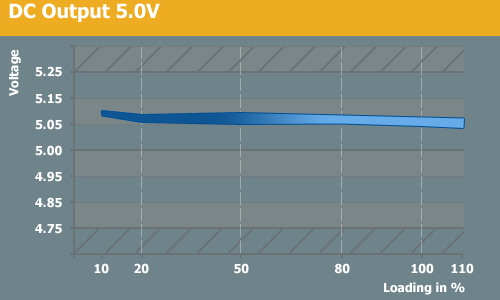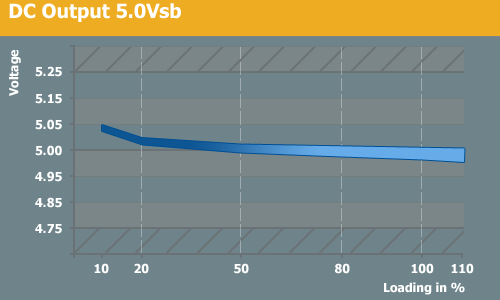Silverstone Decathlon DA700 Super Silent Power Supply
by Christoph Katzer on April 22, 2008 12:00 AM EST- Posted in
- Cases/Cooling/PSUs
DC Output Stability and Quality




The voltage regulation works quite well with the DA700 as we can see above. We see some larger drops with the 3.3V rail but it drops from being somewhat high to the ideal 3.30V which is better in our opinion than starting at 3.30V and ending up low. The 5V rail is nearly flat, staying in the 5.05V to 5.1V range throughout the tests - slightly high, but well within spec. The more important 12V rail, which was actually designed with four separated rails, has similar good readings and always stays just above the specified 12.00V. The fluctuations are so small that the graph shows a very thin line. As for the output quality, we can say the Silverstone DA700 has very clean results as well. All of the rails performed within specification and the 12V rail had just a little over 20mV ripple at higher loads.










20 Comments
View All Comments
Spacecomber - Sunday, April 27, 2008 - link
Does Silverstone offer any lower wattage Decathlons of the same type as this reviewed model, i.e., with the same very quiet characteristics? 700 watts is just way more power than I can imagine needing for a music server/home theatre PC.And, I didn't understand why Silverstone and Impervio were considered to be unlikely partners. Can anyone shed a bit of light on that remark?
Finally (and least), I think this sentence on the first page is missing a word, "However, with this new Decathlon Silverstone is trying a different approach from what we have previously [seen?]."
Thanks.
Christoph Katzer - Sunday, April 27, 2008 - link
Silverstone does have the ELEMENT series with 400 watts which is very nice as well.The remark on Silverstone and Impervio was made because I said once that Impervio was formed by Silverstone. I then had major complaints from Impervio coming in since there were companies wanting to stop working with them if they belonged to Silverstone.
Clue69Less - Wednesday, April 23, 2008 - link
Based on the review title, I'd expected to see some comparison data. Maybe the PCP&C Silencer 750 and the Zalman HP-700 units would be good to compare if having ample power in a quiet package. Sure, this review has quantitative SPL results but it would be nice to see an actual, real-time comparison. You know, like science typically does.Kanchenjunga - Wednesday, April 23, 2008 - link
Your methodology claims a 4 decimal place accuracy but the graphs aren't even visually accurate to 1 decimal place. The graphs should also reflect identical voltage ranges for equidistant lines but they don't, the first lines above and below nominal are only half or less the voltage range as the equidistant lines in the rest of the graph. As a result the voltage drops beyond a plus or minus 1% range aren't reflected accurately in the shape of the curve.Also the 11.94V line in the 12V graph should be 11.64V and the 3.14V line should be labeled 3.13V if the graphs are supposed to be consistent above and below nominal.
Stefan555 - Tuesday, April 22, 2008 - link
The label on the psu is not more complicated than on any other psu, its very easy to understand, I cant see what makes this label more complicated than any other label.No offence Chris, but are you really sure you know how to read the labels?
whatthehey - Tuesday, April 22, 2008 - link
The Greater Internet Fuckwad Theory in full effect (http://www.penny-arcade.com/comic/2004/03/19/">http://www.penny-arcade.com/comic/2004/03/19/ for the uninformed).The label lists combined 3.3V and 5V, but nothing about the 12V. 58A and 12V works out to 696W, which means you can't count on getting anywhere near 58A from the 12V lines. And there are four 12V rails, but no mention of the breakdown of power distribution. Hell, the label doesn't even let you know there are four rails! Yes, that's so much better than, say, the way Xigmatek did their labels: http://www.anandtech.com/casecoolingpsus/showdoc.a...">http://www.anandtech.com/casecoolingpsus/showdoc.a...
It's not a huge complaint, but given the parity between power supplies it seems to me that a lame-ass label deserves a mention. Just like your comment deserved a rebuttal. No offense, but are you sure you know how to read technical reviews?
jonnyGURU - Tuesday, April 22, 2008 - link
The label lists combined 3.3V and 5V, but nothing about the 12V. 58A and 12V works out to 696W, which means you can't count on getting anywhere near 58A from the 12V lines.
Since there is bound to be a minimum load requirement on the other rails, it is true that it would be difficult to load the +12V up to 696W without going over 700W, but I fail to see how this makes for an argument that the label is any less comprehensive. When other PSU companies list the +12V capability in watts, I hear people complain that they have to bust out a calculator and divide by 12. Is it really so hard to go from wattage to amperage and vise versa when the voltage is known?
Unless you're using this sentence as a platform for your argument:
Obviously, that load is not possible with the combined power of all three main rails; doing the necessary math, if you put a load of 180W on the 3.3V and 5V rails, that leaves 520W for the 12V rail, or 43A.
I believe if you look at virtually ANY quality power supply on the market you're going to find that if you full load whatever the +3.3V and +5V combined is, that there is significantly less power available to the +12V. I say "quality" because any PSU that gives you a total wattage number that IS the sum of it's +3.3V and +5V and it's +12V is likely lying about it's actual total output capability. This has everything to do with a power supply's capability to convert AC to DC and then the unit's ability to regulate X amount of DC on the secondary side. Never does 3.3V + 5V + 12V = PSU's total capability.
And there are four 12V rails, but no mention of the breakdown of power distribution. Hell, the label doesn't even let you know there are four rails!
I must have missed this because nowhere could I find that this is a PSU with a split +12V rail. In fact, in this review it says: "The DA700 comes with a single 12V rail rated for up to 58A" and on SilverStone's website it says "Class-leading single +12V rail with 58A at 50?" so where are we getting four +12V rails from?
strikeback03 - Tuesday, April 22, 2008 - link
Bottom of page 4: " The more important 12V rail, which is actually four separate rails, has similar good readings and always stays just above the specified 12.00V"Stefan555 - Tuesday, April 22, 2008 - link
Yes, thats a statement in the review. Silverstone sell the psu as a single rail unit. You must prove Silverstone is hiding the truth, not just make a statement out of no-where.Without proof the statement is worth nothing
Christoph Katzer - Tuesday, April 22, 2008 - link
If someone would only look through all of the date before making comments. Please have a look in the gallery added to the Internals page. One might find a picture with the different 12V rails clearly marked on the PCB... additionally one might find the four different color markings on the yellow 12V cables on various kinds of pics from the article.